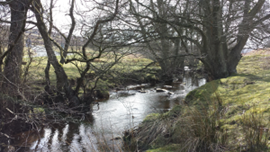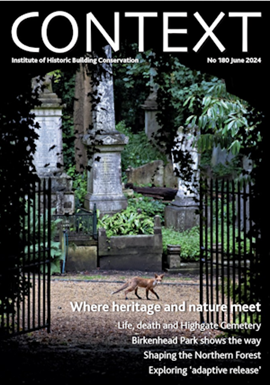Annual conservation management statements Part 2
This article was created by The Institute of Historic Building Conservation (IHBC). It was written by Bob Kindred MBE BA IHBC MRTPI and published in September 2014. You can see the original article on the IHBC website.
Because of its length, this article is in two parts. The first part can be seen at Annual conservation management statements.
Contents |
Research, Publication, Promotion and Miscellaneous Functions
While these activities play a subsidiary or occasional role, they should not be omitted from an ACMS. Notwithstanding constraints on training budgets, it is essential that technical and professional competence should be maintained. The ACMS is a valuable tool by which to emphasise that attendance at appropriate seminars, workshops, conferences and courses, particularly those accredited under schemes for Continuing Professional Development are a compulsory requirement of membership of the relevant professional institutions (for example RTPI and IHBC). Inclusion in the ACMS of the need to maintain CPD should help ensure that sufficient resources are earmarked to meet professional institutional requirements which in turn should result in a better trained, motivated, retained workforce.
It is axiomatic that the professional specialist conservation function will require the preparation of reports. This workload should be identified in the ACMS as this will inevitably involve the undertaking of research and disseminate information through publication of technical guidance notes and explanatory leaflets in printed and electronic media. They will concern, for example, the appropriate repair and maintenance of historic buildings, the operation of planning legislation and local architectural history to promote interest in the principles and good practice of historic building conservation.
It is good practice to maintain a photographic archive and adequate records including photographs of alterations to heritage assets including listed and locally listed historic buildings and structures and changes within conservation areas. This workload item in the ACMS enables prompt response to technical enquiries, the offering of advice on appropriate standards and techniques of repair and maintenance and assists enforcement action. It may be possible to commission some photography via volunteers.
Irrespective of the delegation of any specific powers to the conservation specialist [40] there will be a need to report periodically to the authority's senior management and/or the relevant Committee on, for example progress on implementing the authority's conservation policies, grant aid offered etc., and liaison with outside supported or related bodies. Where decision making authority is not delegated to officers, workload associated with the reporting to the relevant Committee and/or Portfolio Holder should be identifies in the ACMS.
It is good practice for the conservation function to be linked with or integrated into the authority's Emergency Planning procedures and for this to be specifically identified in the ACMS. This usually requires attendance at short notice and/or after-hours when required where, large-scale or serious man-made or natural disasters involve damage to historic buildings, and to be available to offer on-the-spot professional advice to emergency services and associated professionals such as building control officers or fire officers on the safeguarding of historic fabric.
As identified above the service should provide the focus for heritage management input to the Council's wider corporate working on, for example, regeneration, cultural, recreational and traffic strategies and on housing renewal, sustainability, flood risk and tourism issues and emerging regional and local strategies with a historic environment component. Although this is likely to be occasional, inclusion in the ACMS indicates the importance of participation in wider authority initiatives and ensures the integration of heritage considerations.
Clearly one workload item not to overlook is the need to review annually the activities and actions of the ACMS and its inclusion on authority's web pages as necessary to ensure the content remains current.
Service Objective B. Practical technical advice and assistance
It is customary in an ACMS to divide the statement into two parts: advice on development management issues (that is, internal advice); and advice to owners, occupiers and the general public (that is, external advice).
Internal advice
Generally, specialist advice on development management (or the administration and processing of development management casework) is by far the largest component of local authority heritage management workload. [41] The fact that it does not dominate the content of an ACMS does not in any way diminish its importance but equally it must be balanced by other workload considerations, priorities and intended outcomes. By prescribing all the activities of the service, it becomes easier to apportion time and deploy resources to ensure all the Council's approved Service Objectives are being met or where they fall short and to what degree.
The ACMS should make it explicit that it is good practice to offer pre-application advice and negotiation with potential applicants for statutory consents when requested; to make site visits where necessary; to offer guidance on conservation policy and principles (either in conjunction with development management officers or independently).
Work may be identified relating to the need to advise applicants and the relevant Council Officers on the content and standard of, for example, Listed Building Consent applications to ensure suitability for registration in terms of containing sufficient information in accordance with national policy and standards.
Crucially, the key element of this Service Objective is to make explicit in the ACMS the importance of specialist advice to development management officers about conservation policy and principles, national guidance and on matters of detailed design for the proper consideration of historic buildings and conservation areas aspects of applications for planning permission, listed building consent and advertisement consent. This will include joint site visits with development management staff where necessary.
As identified above, where the authority supports a Conservation Area Advisory Committee (or a Design Review Panel) an element of workload is likely to involve the reference of applications affecting historic buildings or conservation areas for comments and appropriate action.
Pre-application advice and advice during the processing of applications is undermined if this is not subject, where necessary, to post-approval monitoring to ensure compliance with conditions, quality assurance or enforcement.
Any need for enforcement arising from non-compliance involving post-approval meetings, site visits and the preparation of case statements, the terms of Listed Building Enforcement notices and court expert witness appearances (in conjunction with the authority's Legal Services) should be identified by the ACMS.
This usually will involve (where necessary with the development management or enforcement officers) advice on the conservation policy and principles, and detailed technical and design advice for planning and enforcement appeals; informal hearings and written representations; and prosecution evidence for criminal breaches of listed building control and conservation area control. Progress on the conduct of heritage enforcement cases should take place on a regular basis to determine if any other procedures may be required such as by the use of injunctions or direct action.
External advice
While this work is usually unquantifiable it defines the accessibility (and approachability) and often the professional competence and efficiency of the service.
Resource and geographical constraints (for example, in large rural districts) may also play a factor and it is good practice to make explicit in an ACMS the importance of workload linked to site meetings with owners and occupiers of historic buildings. This role will cover not only advice on the appropriate alteration, repair and maintenance of historic buildings but also suitable techniques of repair and the availability of appropriate materials.
The ACMS needs also to make clear that technical advice to the general public by correspondence, telephone and through advisory leaflets and web-based material is an essential part of the delivery of the service.
Service Objective C. Schemes of grant aid
If the authority continues to maintain a grant budget for historic building repairs or enhancement and reinstatement, the ACMS should outline the workload involved, for example, the promotion of grant eligibility to owners and occupiers, evaluation of the appropriate standard of the proposed works, decisions on the levels of grant offered; supervision or inspection (and where necessary) specification of works; and payment of grant aid.
An additional and separate function may be to advise building owners, occupiers and the general public about other potential sources of grant aid (beyond any from the local authority itself) and the likely eligibility in the light of any site visits or communications etc.
Where the conservation service is involved in the preparation of, or relevant input into applications and/or supporting material for applications for external funding (from, for example Historic England, the Heritage Lottery Fund, government departments, the European Union or others) this should be included in an ACMS as should acting in any capacity for identifying other historic building and conservation area resources available from outside sources.
Performance Indicators
The performance of conservation services does not readily lend itself to the application of quantitative indicators and assessment of qualitative output can be both subjective and may take a long time to assess. [42] Furthermore, the Best Value benchmarking exercises of the late 1990s showed that direct comparison between seemingly similar authorities need to be approached with caution. It should also be borne in mind that perception has a part to play. For example, the authority's decision to refuse consent for a sub-standard development proposal might be to maintain a minimum acceptable standard, which the proponent would only view negatively as an example of inflexibility.
Generally speaking performance indicators should be SMART:
- Specific – targeting a specific area for improvement.
- Measurable – quantifiable or at least suggesting an indicator of progress.
- Assignable – specifying who will do it.
- Realistic – stating what results can realistically be achieved, given available resources.
- Time-related – specifying when the results can be achieved.
As noted above, ineffective, ill-conceived, time-consuming and resource hungry analysis of performance is unhelpful and often leads to abandonment. It may well be that in constructing an ACMS only specific, regular but under-performing activities need some form of measurement and measurement of qualitative outcomes can be difficult in conservation services. Assignment of the preparation of an ACMS should certainly be the responsibility of officers with a thorough and detailed knowledge of all the facets of the service being delivered. In the restricted climate of local government resources identified in the summary, realism is essential. The ACMS should however define the time-related aspects quite easily.
A review of the ACMS will show workload that is regular and workload that is randomly generated or intermittent. If the workload is enumerated it is possible to assign timescales for compliance or completion. Although these are likely to be long-range, medium-term and short-term, some will have no timescale assigned to them but there will be an opportunity to review all of them annually.
A few typical examples might include:
Long-range
- Review all conservation area boundaries and the scope for new conservation area designations every five years;
- Review the scope and coverage of Heritage Partnership Agreements every five years in conjunction with Historic England and owners.
- Reviewed annually all listed buildings for condition and occupancy, for the purposes of the authority's historic buildings database and biannually for the Heritage at Risk Register as a basis for monitoring and action prompting repair. [43]
Medium-term
- Review quarterly the authority's Listed Buildings to ensure progress on periodic survey, repair, and application for statutory consents under planning, fire, building control and disabled access regimes; and discuss heritage implications with other relevant Service Managers and ensure integration with statutory Asset Management.
- Participate in quarterly meetings of the sub-regional/county conservation officers' forum.
Short-term
- Provide specialist advice in writing by telephone, e-mail or by site visit on request to owners and occupiers of historic buildings and to the general public within 7 working days (where practicable). [44]
- Deal with requests for policy, technical and detailed design guidance from development management case officers on the heritage significance aspects of applications for planning permission, listed building consent and advertisement consent in particular - and general design advice (when requested) - within 10 working days.
- Respond to any enquires on matters of conservation policy and practice relating to historic parks, gardens or cemeteries within 14 working days.
Not time specific [45]
- Prepare and regularly review a list of buildings of special local townscape interest.
- Ensure all conservation areas to be covered by a comprehensive conservation area character description and management plan to national best practice standards.
- Provide emergency out-of-hours cover and advice for disaster planning affecting historic buildings identified in the council's Emergency Plan whenever required.
- Maintain an effective photographic record of all Listed Buildings and all buildings subject to Article 4 Directions and other buildings in conservation areas as resources permit. [46]
Concluding Remarks
Readers who have reached this point in this Note may conclude that the preparation of a ACMS is too complex and time consuming be worth undertaking but perseverance is to be encouraged as it is only by fully assessing and specifying all the functions being undertaken or needed to deliver a balanced conservation service to an acceptable standard that the question of proper resourcing can be addressed. “We had no idea you did all that” is a common response.
This is one of a series of occasional Guidance Notes published by The Institute of Historic Building Conservation (IHBC). IHBC Guidance Notes offer current and recent guidance into topics that we consider crucial to the promotion of good built and historic environment conservation policy and practice. The Notes necessarily reflect knowledge and practice at the time they were developed, while the IHBC always welcomes new case examples, feedback and comment to research@ihbc.org.uk for future revisions and updates.
--Institute of Historic Building Conservation 10:04, 23 Jun 2016 (BST)
Endnotes
[1] In June 1995 the Department of National Heritage issued strategic guidance to all local authorities achieving unitary status on 1 April 2006 emphasizing the importance of maintaining effective heritage management services. This was in fact the first centrally defined model of local government heritage service provision.
[2] Some services were to be the subject for the first time of compulsory competitive tendering.
[3] In 2004 the initial key NPIs were broken down as follows. KNPI-1, gave the proportion of council-owned historic assets receiving regular review of condition with related maintenance and repair programmes (as a percentage of the total number of properties on a comprehensive register of the local authority's heritage assets). KNPI-2 noted the proportion of conservation areas in the authority with character appraisals in accordance with national guidance. KNPI-3 detailed a Sites and Monuments Record covering the area of the Local Authority; and, KNPI-4 addressed the level of public satisfaction with the local authority service for the historic environment and its outcomes. Only KNPI-2 was applied nationally and its status as an NPI was questionable as it was an arbitrary statistical exercise not a measure of improved performance over time. It did however enable authorities to allocate funds to complete appraisals where these were lacking.
[4] The Excellence in Planning work was initiated via the Planning Officers Society in conjunction with IHBC, IfA, ALGAO, English Heritage, DCMS; ODPM, the Audit Commission and CABE.
[5] 'Moving towards excellence in urban design and conservation' 2003, published jointly by CABE, English Heritage and the Planning Officers Society. Publication Product Code: SASS 50789. The IHBC's role was not acknowledged and the priority accorded to urban design over conservation was a reversal of the original emphasis, once CABE had become involved and undertook to publish the document.
[6] KPI-1 was abandoned because of central government's anticipated cost and the request by local authorities for additional resources; KPI-3 was abandoned as being a non-statutory service; KPI-4 was abandoned because a common set of measures could not be agreed for widely differing models of service delivery and wide ranges of heritage assets.
[7] National Performance Indicators were abandoned by the government partly on principle and partly because of the overall cumulative cost of compilation - estimated by the Local Government Association to be cost local government £500M per annum at the time.
[8] www.helm.org.uk
[9] Commenced 1998 – involving Ipswich BC (lead LPA); Bath and NE Somerset C; Bedford BC; Carlisle CC; Chester CC; Lancaster CC; and Swale DC.
[10] See Note 1 above.
[11] 'Why planning authorities must have conservation skills'. http://www.ihbc.org.uk/skills/england/index.html
[12] Specific aims and objectives clearly might be less likely in authorities with a relatively small number of heritage assets.
[13] Heritage related objectives may extend to a wide range of council services, for example, inter alia a role in encouraging learning, new investment, innovation, regeneration and sustainable growth under an economic goal; helping to create an attractive historic environment (particularly for public transport) under a travel and transport goal; and forming an integral part of cultural activity and leisure opportunities including issues such as the quality of public space and public art.
[14] This may include discreetly identified associated services for example urban design or arboriculture and landscape work
[15] See Note 12 above.
[16] Provision of a 'full' service may be seen as aspirational at a time when resources are under pressure, but it is only by articulating what a full service comprises to protect the authority's heritage assets, that a case can be made for what is - and is not - being done or is - or is not -being prioritised.
[17] Grant budgets (for repairs, occasionally for enhancement) have declined or disappeared in many authorities in recent years but have not disappeared entirely. They are useful in facilitating works and influencing the standard of repairs and are a catalyst for levering additional funding from, for example, the HLF.
[18] In exceptional circumstances there will be workload associated with World Heritage Site Inscription and subsequent management.
[19] This may be influenced by the evolving priorities of the National Heritage Protection Plan but will typically still include, for example, working notes of potential spot-listing cases, where applications backed by the local authority are accorded additional weight.
[20] Defining the media, that is by correspondence, telephone and e-enquiries, advisory leaflets and via the web, articulates the range of communications needing to be handled day-to-day.
[21] Many authorities maintain an up-to-date comprehensive, integrated statutory list, database and photographic record, but this is resource intensive and usually separate from any HER which can be difficult to access promptly.
[22] A timescale should usually be specified: annual, biannual, quinquennial as appropriate.
[23] This may be the authority's own Register and/or compiled/published jointly with a consortium of other authorities and may be compiled using volunteers.
[24] Heritage-at-risk is recognized to be large-scale, long-term, resource intensive workload and consequently in most authorities is accorded a low priority but it is a crucial benchmark of the authority's commitment to heritage management.
[25] As a separate and parallel procedure from statutory asset management.
[26] See for example `Maintaining local authority heritage assets' [ODPM/DCMS /English Heritage 2003].
[27] Generally in line with the job description defined in English Heritage good practice guidance [2007].
[28] This may extend to regular or periodic training of other Councillors in particular Planning Committee members.
[29] Some authorities may also need to keep under review the provisions relating to an Urban Archaeological Database.
[30] Local list schedules approved by Council resolution and identified as 'non-designated heritage assets' carry weight in the consideration of planning appeals. Such lists go by various titles as covering buildings of local architectural merit, townscape interest and equivalent.
[31] Guidance is provided at: www.helm.org.uk
[32] Part II, Sections 69-80 of the Planning (Listed Buildings and Conservation Areas Act 1990.
[33] Including any proposals for regeneration and area enhancement.
[34] For good practice standards see: http://www.english-heritage.org.uk/professional/advice/advice-by-topic/landscape-and-areas/conservation-area-guidance/
[36] Ibid.
[37] It is good practice to do this at least annually.
[38] Including but not necessarily always involving statutory notifications for consent applications under the relevant Circulars and Listed Building Directions.
[39] For non-statutory bodies workload in the ACMS might also extend to, for example, acting as the authority's central technical and professional reference point relating to the War Memorials Trust and ex-armed services organizations on all matters relating to public war memorials.
[40] For example the service of Building Preservation Notices or the administration of grants.
[41] Successive annual surveys of local authority conservation provision by the Institute indicate that specialist advice on development proposals may occupy between 50% and 90% of officer time depending on asset numbers, inter-disciplinary skills, operational procedures etc.
[42] Examples include the extended length of time before a development proposal is implemented; or the success of a repair technique. In some cases the seamlessness of a repair and it 'invisibility' may be the measure of success and consequently completed work about which the general public may be unaware.
[43] Alternatively this might be on a percentage basis, for example, 10% or 20% per annum.
[44] In some cases the workload pressures or timescale or geographical location might make this impractical and the target may be longer or aspirational but be subject to realistic annual review.
[45] Some of these might be aspirational.
[46] Adding the phrase 'as resources permit' allows an additional degree of flexibility, but should not be an excuse for an annual review to revise the ACMS.
Find out more
Related articles on Designing Buildings Wiki
- Annual conservation management statements.
- Archaeological officer.
- Archaeology and construction.
- Conservation area.
- Conservation area.
- Conservation officer.
- Designated areas.
- Enterprise and Regulatory Reform Act 2013 and listed buildings.
- Heritage partnership agreement.
- Historic England.
- Institute of Historic Building Conservation.
- Listed Building Consent Order.
- Listed Building Heritage Partnership Agreements.
- Listed building.
- Local Listed Building Consent Orders.
- Planning authority duty to provide specialist conservation advice.
- Scheduled monuments.
- Sites of Special Scientific Interest.
IHBC NewsBlog
Volunteers work to transform 100-year-old ‘hidden’ building into bothy
The building, named Druimnashallag, is located southeast of Oban.
The new ‘Arches for HERs’ Demo site, from the Getty Conservation Institute via HE
It shows how organisations responsible for historic environment records (HER) management can benefit from its powerful features.
ICOMOS-CIF 2024 Symposium celebrates 40th anniversary in Venice
It aims to critically review current practices and theories of conservation of built heritage around the world, and more.
HES establishes new national centre for retrofit of traditional buildings
HES plans to develop the centre follows £1m of funding from UKRI Arts and Humanities Research Council.
High Court rejects oral appeal against tower block decision in historic Bloomsbury
The request was for a full Judicial Review hearing against Camden Council’s approval of a 74m-high tower block in Bloomsbury.
Mayor of London and Government announce bold plans to transform Oxford Street
Plans include turning the road into a traffic-free pedestrianised avenue, creating a beautiful public space.
Crystal Palace Subway, for 160th anniversary
The remarkable Grade II* listed Crystal Palace Subway in South London begins a new era following major restoration.
National Trust brings nature back to an area twice the size of Manchester in less than a decade
The National Trust has achieved its aim of creating or restoring 25,000 hectares of priority habitat on its land by 2025.
18th-century hospital in York to become sustainable homes
A former mental health establishment founded by a Quaker in 1792 is to be converted into 120 energy-efficient homes in York.
Context 180 Released - Where Heritage and Nature Meet
The issue includes life, death, Forests, bats, landscapes and much more.
















